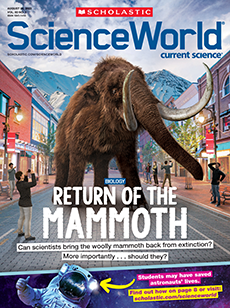In Appleton, Wisconsin, overgrown lawns indicate that “No Mow May” has begun. Insects zip among dandelions and clover. Colorful signs proclaim: “Pardon our weeds, we’re feeding the bees!” For one month out of the year, many Appleton residents pledge to stow away their mowers and let their lawns transform into miniature meadows.
In 2020, Appleton became the first U.S. city to join the global No Mow May effort. Today cities across the country are taking part. In spring, bees and other insects are “just emerging from hibernation, and they’re very hungry,” says Laura Rost, a coordinator for the conservation initiative Bee City USA. These pollinators visit flowers to sip nectar. In the process, they transport pollen grains between plants and help them reproduce. But in many areas, there aren’t enough flowers for native insects to feed on. That’s why some people temporarily stop mowing to let flowers bloom.
About 40 million acres of turf, or grass lawn, covers the continental U.S. All that grass requires constant watering. People also apply harmful chemicals, like herbicides to wipe out weeds and fertilizers to help the grass grow. Gas-powered mowers also produce greenhouse gases, which trap heat in Earth’s atmosphere, causing climate change.
No Mow May is just one small way to deal with problems created by grass lawns. Many people go further, replacing all of their grass with native plants, says Rost. Read on to learn more reasons why people are ditching their lawns to help people, pollinators, and the planet
Lawns are overgrown across Appleton, Wisconsin. That means “No Mow May” has begun. Insects zip among dandelions and clover. Colorful signs proclaim: “Pardon our weeds, we’re feeding the bees!” For one month out of the year, many Appleton residents promise to stow away their mowers. They let their lawns turn into miniature meadows.
In 2020, Appleton joined the global No Mow May effort. It became the first U.S. city to do so. Today cities across the country are taking part. In spring, bees and other insects are “just emerging from hibernation, and they’re very hungry,” says Laura Rost. She’s a coordinator for the conservation initiative Bee City USA. These pollinators visit flowers to sip nectar. In the process, they carry pollen grains between plants. That helps the plants reproduce. But many areas don’t have enough flowers for native insects to feed on. That’s why some people temporarily stop mowing. They let the flowers bloom.
About 40 million acres of grass lawn covers the continental U.S. All that turf needs constant watering. People also apply harmful chemicals. They use fertilizers to help the grass grow and herbicides to wipe out weeds. Gas-powered mowers also produce greenhouse gases. These gases trap heat in Earth’s atmosphere. That causes climate change.
So grass lawns can create problems. No Mow May is just one small way to deal with them. Many people go further. They replace all their grass with native plants, says Rost. There are many reasons people choose to ditch their lawns. Read on to see how this helps people, pollinators, and the planet.

